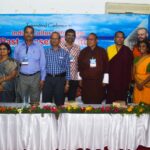About Conference
India today is exploring the lost cultural roots and missing links with the outside world, especially in the context of its profound cultural, historical and commercial relations with the countries around it for the last two and a half thousand years. Though it is lagging behind China in economic prowess, it has the experience of guiding the world in the intellectual, ideological and cultural domains. Santhas, Mahantas and Bhikkhus of India have been the torchbearers and enlightened the world. On the eve of India holding the Presidency (from December 1, 2022 to November 30, 2023) of the G20, the premier objective now is to shape and strengthen global architecture and governance on all major international issues.
The theme for India’s G20 Presidency is ‘Vasudhaiva Kutumbakam’, or ‘One Earth-One Family-One Future’. The most important moral value of Maha Upanishad, VI.71-73, the above-stated ‘Vedantic Thought,’ advocates the cause of holistic development and respect for all life forms, an extension of the ancient Indian concept. This idea of ‘oneness of being’ subscribes to ‘Harmony’, when many [things] are restored to some unity.
Despite all superficial diversity, our life in illusion must experience and endure the feeling of oneness through love brought about amongst all the nations, castes, colours and creeds. Further, the Rigvedic dictum ‘Bahujanasukhaya Bahujanahitaya cha’ has urged humanity to follow the idea of “welfare of the many, the happiness of the many”. Eventually, exploring India’s link with the outer world is timely and relevant.
India’s coastal regions, such as Bengal, Kalinga, Andhra Pradesh, Tamilnadu, Kerala, Karnataka, Maharashtra and Gujarat had established important cultural and trade links with Southeast Asia. Thousands of common people and scholars had gone beyond its limited geographical boundary and remained instrumental in ushering political, social and religious changes. Incidentally, the cultural fusion of India and Southeast Asia is a flow that has been in motion for thousands of years.

The ancient history is vocal in asserting that people from the Kalinga region went to Java, Sumatra, Malaya and other islands by establishing Sri Vijaya and Shailendra empires there. The descendants of Kaundinya also based their domains on hundreds of islands there.
India’s contact and cultural influence on Southeast Asia are essential to revisit the tenets of Asian history. The earlier view of nationalist historians characterising the indigenous population as passive recipients of Indian culture no longer holds good. Indian culture was diffused through autochthonous societies of Southeast Asia, whose material base was of such a standard that it could assimilate elements of that culture. The Southeast Asians knew the metal industry, developed agriculture and acquaintance with marine technology. The whole process of Indian cultural influence was the interaction between India and Southeast Asia.
As the culture of India consists of a plurality of traditions, the part played by Odisha was very significant. Through its numerous ports on the long coastline, Odishan contact has flowed out in successive waves to different regions of Southeast Asia. Located on the eastern coast of India, the ancient state of Kalinga extended from the Ganges to the Godavari River, including parts of modern Odisha, Andhra Pradesh and surrounding areas. The Kalinga janapada, as is accepted, originally comprised the area covered by the Puri and Ganjam districts. The navigable rivers, including the Ganga, Mahanadi, Vamsadhara and Godavari provided access to the interior, where precious and semi-precious stones were found, and their deltas provided natural harbours. From these harbours, the region’s people traded by sea with Ceylon in the south and Burma in the east, including Southeast Asia, Indochina and China. The maritime activity of Kalinga was so extensive that the Bay of Bengal was once called the Kalinga Sagar.
The people of Odisha (Ancient Kalinga) believe that for 2,800 years, these south-eastern island groups were in close contact with the Kalinga people. Along with traffic and commodity exchange, there was also the ideological and cultural exchange between Kalinga and these island groups in the Kalinga Sagar, as stated. Bali Yatra commemorates the rich maritime history of Odisha and its ancient trade affairs with Southeast Asia and Sri Lanka.
Speaking to the Indian community on the sidelines of his participation at the G20 summit, Prime Minister Narendra Modi praised the annual trade and commerce fair held every year on the banks of the Mahanadi river in Cuttack.
Keeping these in view, Utkal University and Institute of Media Studies (IMS) in association with One Asia Foundation are jointly organising the second edition of International Conference on Indian Cultural Heritage (ICICH) with the theme ‘Kalinga & Southeast Asia: The Civilisation Linkages’ at Bhubaneswar in Odisha from 27 to 29 July, 2023.
About Us
India today is exploring the lost cultural roots and missing links with the outside world, especially in the context of its profound cultural, historical and commercial relations with the countries around it for the last two and a half thousand years.
Important Dates
- Deadline for Abstract Submission: June 5
- Acceptance Notification: June 10
- Registration Deadline: June 15
- Deadline for Full Paper Submission: June 30
- Conference Dates: July 27-29
- Brochure
Contact Us
- Conference Secretariat, Institute of Media Studies, OCHC Complex, Kharavel Nagar, Janpath, Unit-3, Bhubaneswar, – 751001, Odisha, India.
- incon2017@gmail.com / inconodisha@gmail.com
- +91-7077664372
- +91-9861977068









